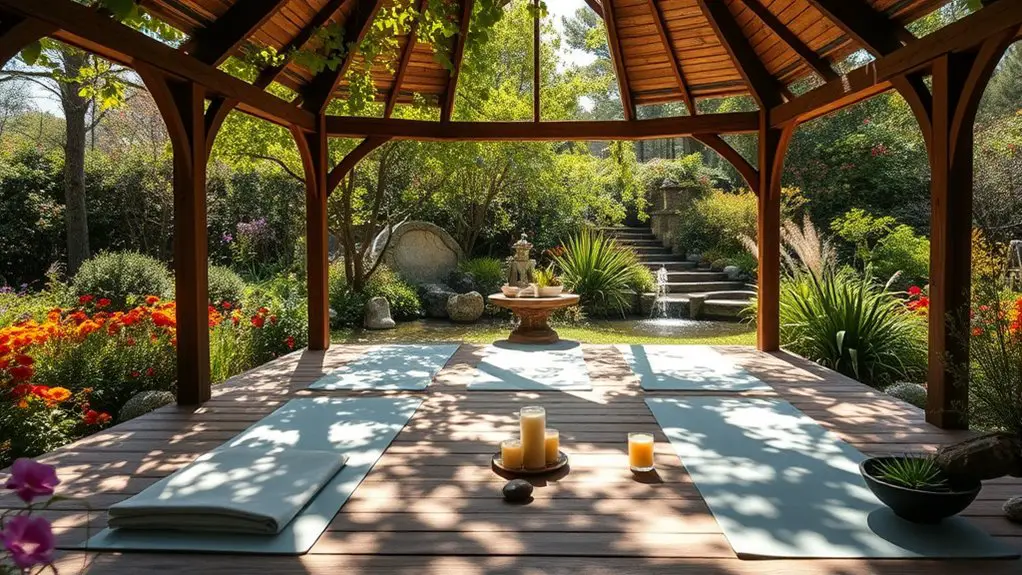To plan a yoga and meditation retreat in your gazebo, choose a serene time, preferably in spring or autumn, to embrace nature’s beauty. Create a calming atmosphere with soft lighting, soothing sounds, and comfortable seating. Select practices that align with your participants’ intentions, balancing mindful movements and stillness. Prepare your space by decluttering and gathering essential supplies like mats and cushions. With a focus on mindfulness, you’ll enhance the experience. Discover more tips to elevate your retreat ambiance.
Choosing the Perfect Time and Setting
When should you consider hosting your yoga retreat, and where can you create the most serene environment? Begin by reflecting on seasonal considerations, as each time of year brings its unique charm. Spring and summer offer warmer weather, encouraging outdoor sessions surrounded by nature’s beauty. Alternatively, autumn’s vibrant colors provide a cozy ambiance, while winter can evoke tranquility, especially in a lovely gazebo. Using a gazebo for meditation can enhance the experience by providing a peaceful environment away from distractions.
Weather factors are essential too; you’ll want to avoid the rain and harsh winds that might disrupt your flow. Research local climate patterns to select a time that aligns with your vision. By thoughtfully choosing both the season and setting, you’ll foster an atmosphere that invites relaxation and rejuvenation, allowing participants to fully embrace their yoga experience.
Creating a Relaxing Atmosphere
After selecting the right time and setting, the next step is to focus on creating a relaxing atmosphere that enhances your yoga retreat experience. Start by utilizing ambient lighting; soft, warm lights or candles can create a serene environment that invites calmness. Consider draping sheer fabrics or using lanterns to diffuse the light gently. Next, incorporate soothing sounds—nature’s whispers, gentle chimes, or calming music can help center your mind and elevate your practice. You might also include essential oils or incense for their aromatic benefits, further enriching the atmosphere. Arrange comfortable seating, cushions, or mats to encourage relaxation. Additionally, consider installing a gazebo ceiling fan to provide a gentle breeze, enhancing comfort during your sessions. By thoughtfully curating these elements, you’ll foster a tranquil space that encourages freedom and deep connection during your retreat.
Selecting Yoga and Meditation Practices
How do you choose the right yoga and meditation practices for your retreat? Start by considering the intentions of your participants. Incorporate mindful movement practices, like Hatha or Vinyasa, which encourage connection to the body and promote relaxation. Pair these with breath awareness techniques, such as pranayama, to deepen the experience.
Offer a variety of sessions, ensuring you include restorative practices for those seeking tranquility. You might also introduce guided meditations that focus on self-reflection, fostering a sense of inner freedom.
Be mindful of the flow of your schedule; balance active and passive practices to keep energy levels harmonious. Ultimately, your selections should resonate with the essence of your retreat, inviting participants to connect with themselves fully.
Preparing Your Space and Supplies
Creating a serene atmosphere is essential for your retreat, as it enhances the overall experience for participants. Start by focusing on space organization; declutter your gazebo and arrange seating to promote openness and comfort. Consider adding soft textiles and natural elements to create a calming environment. Additionally, ensure that your gazebo provides protection from the elements, as this will allow participants to fully immerse themselves in the experience without distractions.
Here are some essential supplies to gather:
- Comfortable yoga mats and cushions for relaxation
- Soft lighting or candles to set a tranquil mood
- Aromatherapy diffusers with calming essential oils
Tips for Staying Present and Mindful
While it’s easy to get lost in thoughts or distractions during a yoga retreat, staying present and mindful is essential for deepening your practice. To help you embrace the present moment, start with simple mindfulness techniques like focusing on your breath. Inhale deeply, letting the air fill your lungs, then exhale slowly, releasing any tension. Consider incorporating a short body scan meditation to reconnect with your physical self. When your mind wanders, gently guide it back to sensations and sounds around you. Create a distraction-free environment by silencing devices and minimizing noise. Finally, practice gratitude for each experience, allowing you to cultivate a deeper appreciation for the journey. Embrace this freedom, and let each moment enrich your retreat.
Frequently Asked Questions
How Many Participants Can Comfortably Fit in a Gazebo for a Retreat?
Imagine a serene space, like a gentle embrace of nature. For participant comfort, a gazebo size accommodating six to eight people works well, allowing plenty of room for movement and tranquility during your retreat.
What Should I Wear for a Yoga and Meditation Retreat?
For a yoga and meditation retreat, choose comfortable attire made from breathable fabrics like cotton or bamboo. These materials allow for movement and keep you cool, helping you feel free and focused during your practice.
Can I Host a Retreat in Inclement Weather?
Imagine hosting a retreat while rain patters softly outside. You can create indoor alternatives, like transforming your living room into a serene space. Just guarantee you have weather preparations ready, keeping the atmosphere calming and welcoming.
Do I Need Any Special Permits for Hosting a Retreat?
You’ll want to check your local regulations for permit requirements before hosting your retreat. Understanding these details guarantees a smooth experience, allowing you to focus on creating a peaceful and liberating environment for everyone.
How Long Should the Retreat Last for Optimal Benefits?
For ideal benefits, aim for a retreat duration of two to three days. This timeframe allows for deep relaxation and personal reflection, enhancing your retreat planning while fostering a sense of freedom and rejuvenation.

